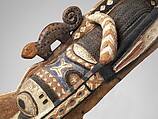Mask (Banda)
Not on view
The character represented in this mask, Banda (also called Kumbaruba by some Baga groups), is a complex composite of human and animal forms. The long horizontal headdress is composed of the face of a human being and the jaw of a crocodile, whose angular teeth are visible along the side of the mask. The human face is characterized by Baga scarification marks as well as a woman's elaborately braided coiffure. The top of the headdress features the horns of an antelope, the body of a serpent, and the tail of a chameleon. Banda headdresses are quite large; this example measures just over four feet in length. Yet despite their unwieldy size, the mask is manipulated with astonishing dexterity and dynamism during performances.
Today, the Banda headdress is danced only for entertainment, although historical documentation suggests that it originally carried an extremely sacred significance. It seems that Banda represented a high and powerful spiritual being that would appear only to privileged society elders. During that period, Banda was used in rituals designed to protect against dangers such as animal attacks or even human malevolence, especially around the time of important male initiation rites. In contemporary Baga society, the Banda performer, invariably a young man, carries the wooden headdress on top of his head. Attached to the underside of the headdress is a large raffia cape that covers the dancer's face and extends to his knees. The performance takes place in a circular arena formed by the crowd and is accompanied by drummers playing on giant wooden slit gongs. The choreography of the dance invokes the movements of various animals, including soaring birds, foot-stamping bulls, and undulating serpents. In the greatest spectacle of the performance, the dancer goes into a dizzying spin holding the headdress aloft, then twirling it in a series of figure eights and plunging it to the ground, finally returning the headdress to his head, all without missing a beat.
Although known to European travelers since the late fifteenth century, Baga society has remained largely inaccessible to Western scholars due to its physical isolation in the marshlands of the Guinea coast. In addition, during much of the twentieth century, the country was under the strict control of a Marxist regime. With the collapse of that government in 1984, Baga society has not only opened up to the West, but also experienced a renaissance of its own, as traditional art forms and rituals like the Banda mask have been reintroduced among the Baga.
The raffia and textile attachments that can be seen on this mask have been reconstructed in 1995.
Due to rights restrictions, this image cannot be enlarged, viewed at full screen, or downloaded.
This artwork is meant to be viewed from right to left. Scroll left to view more.








